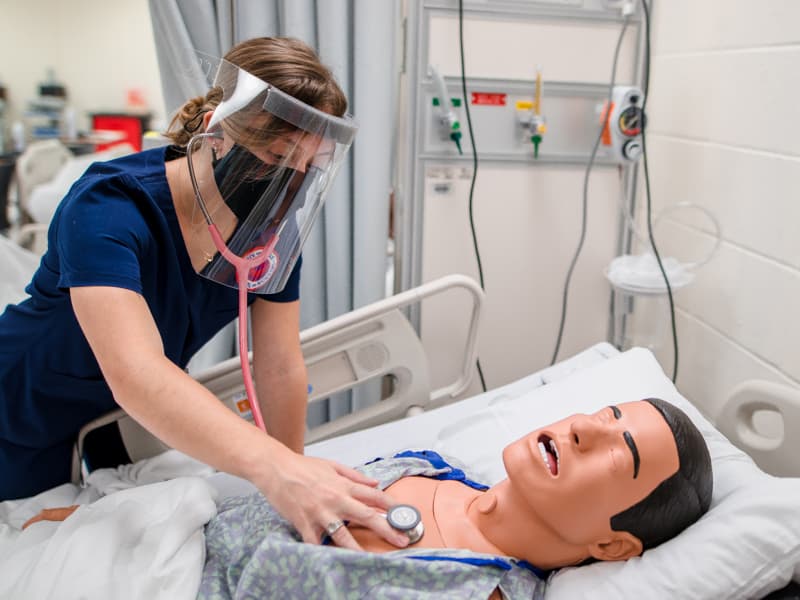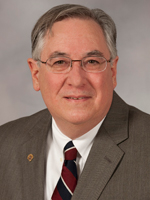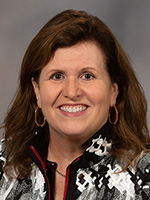Pandemic sparks classroom flexibility, staff creativity for fall semester

Students enrolled in University of Mississippi Medical Center schools this fall will find classroom instruction to be quite different than it was a few short months ago.
When the COVID-19 pandemic first impacted education at the Medical Center during Spring Break 2020, the traditional face-to-face model of instructor-student education was replaced by an online learning paradigm - wherever possible - in the Schools of Medicine, Nursing, Dentistry, Health Related Professions, Graduate Studies in the Health Sciences, Pharmacy and Population Health at UMMC’s Jackson campus.
After the successful transition to online learning by faculty in all seven schools last spring, the Medical Center’s Council of Deans has opted for a hybrid delivery model for classroom content for the upcoming fall semester, according to Dr. Ralph Didlake, UMMC associate vice chancellor for academic affairs.

“Most of the instruction that is traditionally delivered in the classroom will be online,” said Didlake, who chairs the Council of Deans. “Labs and clinical activities will still be required, but will be done in a way that conforms to CDC (Centers for Disease Control and Prevention) guidelines.
“The combination of online and small-group activities will allow us to apply all the CDC guidelines of social distancing and mask wearing.”
The unpredictable nature of the COVID-19 pandemic has required many academic institutions to remain flexible with their short- and long-term educational planning. The Medical Center is no different, Didlake said.
“If there is some sort of governmental mandate, if we shut down completely or if a large number of our faculty, students and staff become ill and we could no longer administratively support academic operations, we would have to reassess the way we’re approaching this,” he said. “Otherwise, we are committed to going forward. Even if the situation improves, it requires planning and scheduling of classes and labs and clinical activities well ahead of time. So we are committed to this model, at least through the fall semester.
“We feel very strongly that we are different from a traditional undergraduate campus. We are trying to put a health care workforce into the field. Obviously, we can’t delay doing that because of the critical need for well-trained health care professionals. So we are going to push forward to get that done as effectively and as safely as we possibly can.”
That includes keeping to the Medical Center’s regular fall academic schedule rather than condensing the instruction period by a few weeks, as other colleges and universities in Mississippi have elected to do.
“We are not altering our academic calendar,” Didlake said. “Many of the IHL (Mississippi Institutions of Higher Learning) institutions are going to shorten the fall semester and end instruction at Thanksgiving break. We are staying with our regular academic calendar as it appears in the Bulletin.”
During each fall semester, about 1,600 students from colleges and universities throughout the state - the majority of them community college nursing students - come to the Medical Center campus for additional clinical training. Didlake said most of those planned visits will not take place in 2020.
“We have affiliation agreements with almost 200 separate programs that range from nursing to physical therapy to laboratory science,” he said. “It’s a broad spectrum of folks who come here for clinical training.
“Almost none of these students will be here during the fall semester in order for us to accommodate our own students’ learning needs in a safe and effective way.”
The council’s decision to implement the hybrid delivery model was made easier by the UMMC faculty’s smooth transition to online learning in the spring, Didlake said.
“The faculty across all of our schools made the transition fabulously well,” he said. “So our ability to deliver content effectively online was not a barrier to this decision.”
As an example, Didlake cited the efforts of faculty and staff in the School of Nursing, under the direction of Dr. Julie Sanford, dean of the school, for tackling the challenge of online learning in an efficient and effective manner for their students.

“They switched to online learning and moved some of their clinical simulations online in the spring,” he said. “They’ve done a great job pulling all of this together and keeping their school strong.
“I have no doubt that their student learning outcomes will not suffer at all.”
Sanford said School of Nursing leaders had been anticipating how the pandemic might impact the school and its faculty, staff and students long before the pandemic arrived at UMMC. She said that preparation was vital to helping SON students achieve their academic goals despite the disruption.
“Our Executive Council in the School of Nursing had developed an action plan before the first COVID-19 case had come to Mississippi,” said Sanford, professor of nursing. “We had weekly town halls during the height of the spring semester for School of Nursing faculty and staff to receive updates. There was no way to predict a situation as calamitous as this pandemic, but we had a pretty good inkling what we would be able to do, and we had an action plan early on.
“Many of our programs were already online, so the delivery and methodology was already in place. That helped us, because roughly a third of our students were online students already. Our greatest obstacle was the undergraduate program because we do so much hands-on teaching. We had some real challenges there.”
Sanford said thorough communication was the hallmark of the SON faculty’s success in transitioning to an online instructional environment.
“We had success because of communication, planning and flexibility,” she said. “Our faculty worked long hours to smooth the transition to online delivery. They were required to quickly develop innovative instructional methodologies.
“Faculty had to think totally out of the box, to try new things, and they had great success. Our support personnel for distance education, our instructional designers, played critical roles as well.”
Sanford said she was able to draw upon her school’s successful transition to online learning to help with her decisions as a Council of Deans member.
“The greatest challenge the Council of Deans faced was primarily how we could offer clinical education to our students across all of our programs,” she said. “We communicated with each other, weekends and nights, and we tried to be consistent in our approaches and decision-making.
“Rather than have each school do its own thing, it was critically important for us, as much as we could, to be consistent.”
While limitations of space necessitated the online classroom model, small, in-person group meetings, clinical instruction and lab simulations will augment online learning at UMMC this fall.
“We’ve been in close communication with our colleagues throughout the state, region and nation and professional organizations to determine if what we are doing meets regulatory requirements,” Sanford said. “We all have accrediting bodies that accredit our programs. We have to make sure what we’re doing is in alignment with accreditation standards.
“The School of Nursing faculty and leadership decided early in the summer to use a hybrid approach for the fall. It was less disruptive to faculty and students for planning purposes. Students could make choices and decisions about housing that fits their needs. The fall courses are different from spring courses, and faculty had a lot of work to do to prepare for the fall semester. We didn’t want them to have to prepare for in-person classes and then switch back to the hybrid approach at the last minute.”
According to Sanford, what really supports the success of educational programs at UMMC and the hybrid learning platform is the continued collaboration between the clinical and academic programs at UMMC.
“Our clinical partners in nursing have been incredibly helpful to us,” she said. “We cannot educate our students if we don’t have the clinical learning that’s associated with becoming a nurse. I would say that’s true for most of the other schools as well.
“We are all in this together and the health care system is dependent upon the education of our workforce, no matter what difficulty we may be in. The clinical system needs the nurses we are preparing, and clinical nursing is just as important as those of us on the academic side who are educating our students. I’m really grateful for the collaboration and partnership that has supported our educational mission.”
Despite the havoc wrought by the pandemic to academic programs and the resultant nontraditional format of many educational activities, Didlake said one thing remains constant at UMMC: the quality and exceptionalism of its degree programs.
“The students who come to this campus are high performers,” he said. “They have competed very hard to be here. They know they are going to get good training. It may be a little nontraditional, but they know they are going to get good training. We will get this done and done well.
“Even if it (the COVID-19 pandemic) improves, we are committed to this model, at least through the fall semester. What the spring will bring is impossible to tell at this time. But as soon as it is safe to do so, we do want to return to traditional face-to-face teaching. This is just a temporary measure due to COVID-19.”


